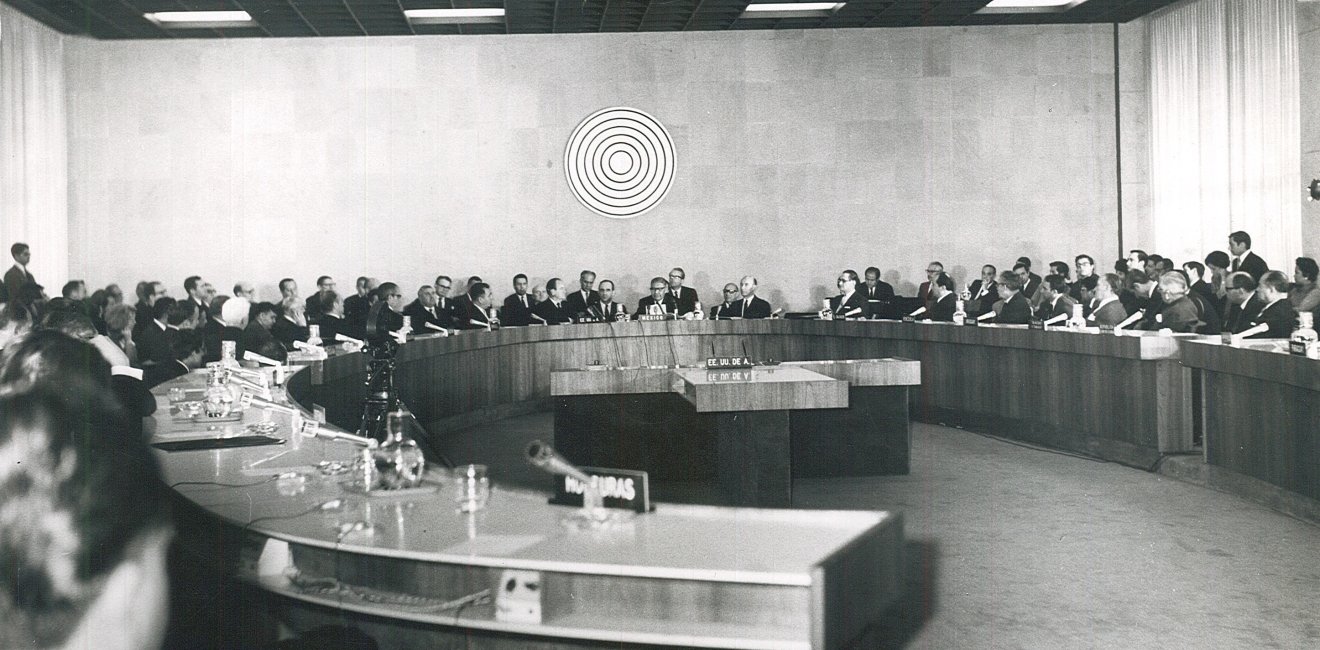Latin America's Nuclear Weapon Free Zone: Fifty Years Later
Fifty years ago today, the Treaty for the Prohibition of Nuclear Weapons in Latin America opened for signature.

A blog of the History and Public Policy Program
Fifty years ago today, the Treaty for the Prohibition of Nuclear Weapons in Latin America opened for signature.

Fifty years ago today, the Treaty for the Prohibition of Nuclear Weapons in Latin America opened for signature
Commonly known as the “Treaty of Tlatelolco” (deriving its name from the neighborhood in Mexico City where its negotiation took place), it came into force in April 1969. The Treaty established Latin America as the world’s first nuclear weapon free zone (NWFZ) in an inhabited region and the only one until the denuclearization of the South Pacific in December 1986.
A success story in the long-run, Tlatelolco faced adversity at its outset. Competing national interests threatened to derail the Treaty’s negotiation and led to compromise in a field that demands resolve. But in the end, such compromise secured the region’s denuclearization and blazed a path for other nonproliferation efforts around the world. In the words of India’s observer to Tlatelolco’s negotiations: the Treaty had “loopholes” but was still a “laudable achievement” for which Latin America could be “justifiably happy.”[1]
The October 1962 Cuban Missile Crisis acted as a catalyst for a Brazilian proposal to establish a NWFZ in Latin America. Over the ensuing year the idea took hold, and the negotiations for Tlatelolco occurred over four sessions between November 1964 and February 1967. At their largest, the negotiations included 21 Latin American nations as well as observers from around the world.
The participating delegations expressed hope that a NWFZ in Latin America could be used to enhance the region’s security, sovereignty, socio-economic prosperity, and prestige. As they saw it, a Latin American NWFZ could prevent another Cuban Missile Crisis or other similar catastrophes and slow nuclear proliferation regionally and globally. It offered a means to preserve the region’s sovereignty against the whims of the nuclear powers and the indiscriminate destructive force of nuclear weapons. It promised to prevent precious developmental resources from being wasted on nuclear weapons programs and offered a path to harness nuclear energy for the region’s peaceful advancement.
That a NWFZ would also establish Latin America as a model for other regions was not lost on the participating delegations. Alfonso García Robles, Mexico’s head delegate and the individual most responsible for the Treaty, reminded his counterparts that, “We are working for the benefit, not only for the countries of Latin America, but also for mankind.”
These ideals, however, confronted competing national interests which threatened to derail the conclusion of the Treaty.
No two issues better exemplified this conflict than the debates surrounding the definition of a nuclear weapon and membership under the Treaty. Nations like Argentina and Brazil sought to preserve the right to conduct “peaceful nuclear explosions” (PNEs), which they argued could augment their security, sovereignty, socio-economic prosperity, and prestige.
Other nations, led by Mexico and with support from the nuclear superpowers, argued that PNEs were no different than nuclear weapons. In the end, the Treaty included clauses that left the issue open to interpretation.
Meanwhile, debate existed over membership under the Treaty. Brazil argued that the Treaty should only come into effect upon unanimous adherence by Latin American nations, extra-regional nations with territories in Latin America, and the world’s nuclear powers. From Brazil’s perspective, the Cuban Missile Crisis had made clear that one rogue nation could endanger Latin America’s very existence.
On the other hand, Mexico pushed for the Treaty to come into existence on a nation-by-nation basis. It was unrealistic, Mexico asserted, to expect every eligible nation to adhere immediately to an unprecedented set of arms control measures.
In the end, the delegates adopted a Chilean solution that called for a majority of the Latin American nations negotiating Tlatelolco (11) to adopt the Treaty before it could formally come into existence. In practice, this compromise meant that Latin America’s NWFZ could be sidestepped.
Tlatelolco faced challenges once it opened for signature. While the negotiations provided Argentina and Brazil, the two most advanced nuclear nations in Latin America and traditional rivals, a space to cooperate over issues pertaining to nuclear nonproliferation, neither nation became a full adherent to the Treaty until the mid-1990s.
Such a peaceful outcome was by no means assured. In the 1970s and 1980s, a number of international observers believed that Argentina could soon develop nuclear weapons. Brazil embarked on a secret military nuclear program in the mid-1970s with a similar potential.
Cuba conditioned its support for a Latin American NWFZ upon the inclusion of all US military bases in the region, Puerto Rico, and the Panama Canal, as well as the return to it of the US military base at Guantánamo. With its demands left unfulfilled, Cuba refused to participate in the negotiations for Tlatelolco and did not become a full member to the Treaty until 2002. Meanwhile, it took four of the world’s first five nuclear powers between five and 32 years to fully adhere to the Treaty once it came into effect.
Tlatelolco also faced adversity during the 1982 Falklands/Malvinas War. Both during the War and in its aftermath, Argentina accused Great Britain of violating Latin America’s NWFZ by deploying nuclear propelled submarines to the demarcated geographic area and by entering the NFWZ with ships carrying nuclear weapons—possibly with the intent of using them in the conflict. Argentina’s accusations brought controversies over Tlatelolco’s geopolitical demarcation and definition of a nuclear weapon back to the forefront.
Despite such adversity, Tlatelolco is a success. Today, every Latin American nation is a full adherent to the Treaty, as are the five most advanced nuclear nations in the world. Tlatelolco has also served as a model for other nuclear nonproliferation efforts. As historian Jonathan Hunt argues, Tlatelolco acted as an important precedent in the “grand bargain” between nuclear and non-nuclear nations under the 1968 Non-Proliferation Treaty.
Furthermore, Tlatelolco inspired denuclearization in other inhabited regions of the world. There are currently NWFZs in Africa, Central Asia, Southeast Asia, and the South Pacific, while Mongolia unilaterally established itself as a NWFZ.
As US President Lyndon Johnson said 49 years ago today, Tlatelolco is “a realistic and effective arms control measure of unique significance – not only to the peoples of Latin America, but to all the peoples of the world.”
Of course, the negotiators of Tlatelolco would agree that until the entire world constitutes a NWFZ, there is still work to be done.
Adapted from Ryan A. Musto, “‘A Desire so Close to the Hearts of all Latin Americans’: Utopian Ideals and Imperfections Behind Latin America’s Nuclear Weapon Free Zone,” Bulletin of Latin American Research (forthcoming).
[1] Telegram No. Mex/162-1/66 From India’s Embassy in Mexico City (N.S. Gill) to Joint Secretary For the UN (V.M.M. Nair), February 16, 1967, SECRET, F.W.II/102(56)/66, National Archives of India, Delhi


A leader in making key foreign policy records accessible and fostering informed scholarship, analysis, and discussion on international affairs, past and present. Read more


The Nuclear Proliferation International History Project is a global network of individuals and institutions engaged in the study of international nuclear history through archival documents, oral history interviews, and other empirical sources. Read more



